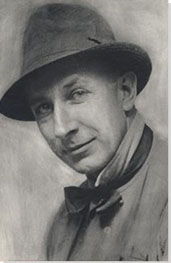Summary of George Bellows
At a time when high art was equated with high society, George Bellows found his inspiration in the lives of the working classes; his New York, rendered in broad brushstrokes and impressionistic daubs, was a city under construction and full of hidden bars and alleyways. Under direction of his mentor Robert Henri, Bellows was one of group painters who took the name The Ashcan School. The group found rich subject matter on the streets of the metropolis, treating their everyday urban subject matter with often dark and gestural paintwork. Having found further inspiration on summer visits to Maine, Bellows became known in the later part of his career for a number of striking, sometimes violent, land and seascapes. The second half of his career as a painter was supplemented with a series of lithographs that helped elevate his popularity amongst the American public.
Accomplishments
- Bellows could be considered something of a revolutionary in the way he exploited the dynamism and energy of his urban surroundings to mount a challenge to the romantic idylls that had, thus far, characterized the country's art directions, such as in American Impressionism.
- An accomplished athlete in his youth (he turned down a career in professional sport to become a painter), Bellows is perhaps best known for several sports-themed works, and especially, a series of boxing paintings. Though he claimed to know nothing about its rules and traditions, his signature work, Stag at Sharkey, involved an illegal bout which he was drawn to because of its raw brutality. Many have read his boxing paintings as the perfect analogy for the trials and tribulations of working-class urban survival.
- While it is true that his city art was rooted in the themes of socio-realism, Bellows's oeuvre reveals a readiness to tackle a range of subject matter and to experiment with new color and compositional arrangements. His preference for broad brushstrokes indicated, moreover, his commitment to artistic freedom of expression and the belief that artists should be free to exhibit their works without pressure from academies and awards juries.
- Though he remains best known for his sports paintings and his city and landscapes, Bellows produced numerous portraits throughout his career. Focusing mostly of family members and friends, Bellows's portraits are distinguished in style from his more impressionist works in the way he applied his paint with a much more delicate touch and attention to fine detail.
The Life of George Bellows
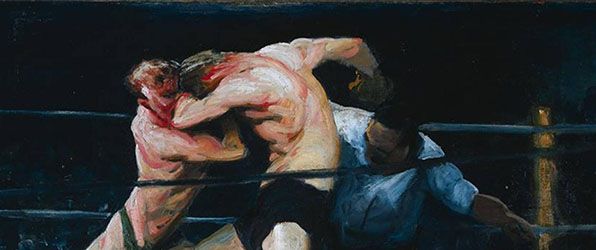
Bellows is best known for his depictions of baseball and boxing. He was an avid ballplayer, and would often pick up a bat throughout his life to alleviate occasional boredom of painting, once even knocking himself unconscious in the process.
Important Art by George Bellows
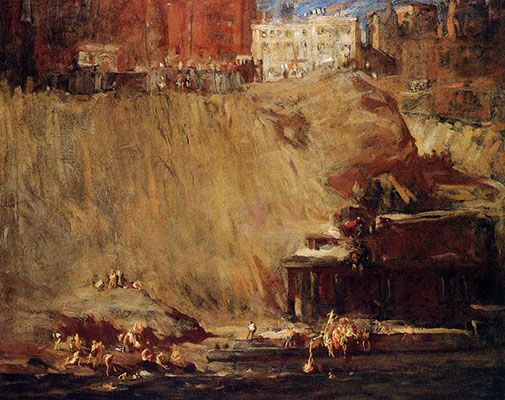
River Rats
The focus of George Bellows's painting River Rats is a group of boys in the foreground lounging and splashing at the insanitary East River. The boys are playing in the shadow of a construction site and behind them is a large mound of dirt that acts as a barrier between the boys and the buildings that make up the cityscaped horizon. Under the direction of his teachers Robert Henri and John Sloan, Bellows took inspiration from the everyday events such as these which he observed while wandering, flâneur-like, through the streets of New York City. Here Bellows creates a stark and grittily modern realism in which the urban poor find their moments of amusement and escape.
This work serves as a good example of how Bellows's approach to painting would secure him a place in the Ashcan School of art. While many of this group's paintings have been interpreted as statements about the social inequality, for Bellows it was more an act of using his canvas to document the world he as he observed it. According to Mary Sayre Haverstock, "if such subjects seemed sordid, and many critics found them so, Bellows saw them in terms of movement and color. [...] social reform was not on Bellows's artistic agenda because, yes, there was beauty in the way the other half lived".
Oil on canvas - Private Collection
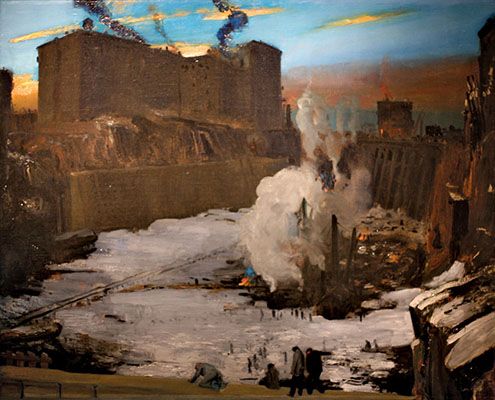
Pennsylvania Station Excavation
In the middle foreground of the canvas is a large area of snow-covered land on which excavation machines are at work. That the digging takes place below street level is clear from the walls around the site and the loosely rendered dark shapes intended to represent city buildings behind it. Steam billows from the machinery while the foreground is broken up by four silhouetted figures, looking down on the activity below.
Perhaps inspired by his father's work as an architect, Bellows took a great interest in the construction of New York City's Pennsylvania Railway Terminal (built between 1903 and 1910 and demolished in 1965). As an adopted son of the city, Bellows would have had many opportunities to stop and observe the ongoing construction in various stages over the years which he then memorialized. Bellows rendered this scene in a modern style consisting of broad swatches of color yet lacking detail to a point that hints at semi-abstraction. The dynamic, unbalanced composition signifies the rapid transformation of New York City in the early part of the century. The frozen winter atmosphere and the onset of dusk, meanwhile, bring an added sense of drama the scene; workmen are humbled both by the sheer scale of the manmade pit and by the unstoppable forces of nature.
When included in a New York School of Art exhibition (under the direction of Robert Henri) this painting, like those produced by his colleagues, was met with mixed reviews. According to Mary Sayre Haverstock however, John Sloan, another teacher at the school, foresaw the importance of these early works and described the exhibition as, "a great show" and suggested that "If these men keep on with this work (they don't need to 'improve') it means that art in America should wake. Henri is as proud as a hen with a brood of ducks". Sloan's prediction proved insightful as the exhibition led to the formation of The Eight, and the Ashcan School.
Oil on canvas - Collection of Brooklyn Museum, New York City
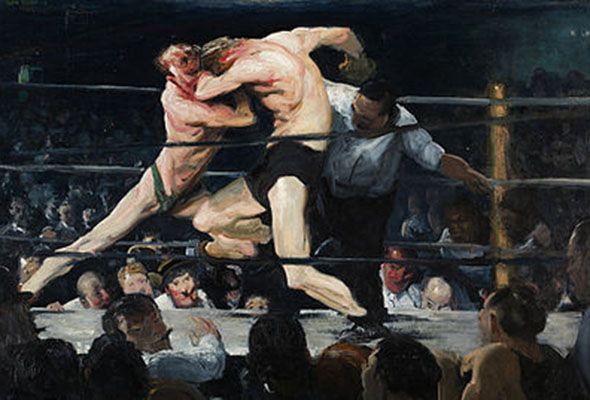
Stag at Sharkey's
One of his many sports/boxing-themed paintings, and one of the most iconic paintings of twentieth-century American art, the work depicts two boxers locked in a hold as they compete in the center of a ring. The rivals are presented through pyramidal composition that hints at classical sculpture. Looking for potential rule infringements, meanwhile, a referee is hunched closely the right of the fighters. A cigar-chewing ringside spectator turns towards the painter, imploring him (or maybe us), through his pointing finger, to give our full attention to the fight at hand. Indeed, Bellows separates the fighters from their surroundings, not only through the ringside ropes, but through the bold use of color and shading. Notwithstanding his ability to intensify the drama of the picture in this way, the quality of the painting is evident in Bellows's skill at rendering the intense physicality - in the interlocked, sinewy bodies of the boxers - and energy - the rumbustious crowd and the urgent (futile?) intervention of the referee - by means of fluent impressionistic brushstrokes.
A sports lover since his childhood, the series of boxing paintings reflected Bellows's growing interest in the sport which developed only after he moved to the city. Amateur boxing bouts were illegal in New York and so contests such as this had to take place in privately run clubs. Tom "Sailor" Sharkey, a US Navy veteran, and former boxer himself, founded his eponymous club as a venue for men seeking to watch and/or participate in amateur boxing bouts. When an outsider came to compete, they were given temporary membership and were known as "stags". Bellows, whose studio was located across the street from the venue, was able to watch fights and produce several preparatory sketches. Yet he once claimed that he didn't know anything about the sport itself - he was "just painting two men trying to kill each other". At the time of the painting, boxing was beginning to shake off its status as a "barbaric" spectacle and was in fact becoming a more gentrified sport. In Bellows's picture, however, the tendency amongst observers is to read it as being analogous to the idea that only the strongest will survive this brutal encounter.
It is interesting to note that in 1917 (by which time prize-fighting had been made legal) Bellows produced a lithograph of the same image (and under the same title). In fact, Bellows produced a total of sixteen boxing lithographs at this time but A Stag at Sharkey's was the most ambitious and monumental of these, indicating, perhaps, the artist's own pride in his most famous painting. In the latter, however, Bellows, who used fine lithographic crayons to delineate his fighters from their more impressionistic surroundings, elected to remove the boundary of the ringside ropes, thereby placing the viewer more fully in the midst of the action.
Oil on canvas - Collection of The Cleveland Museum of Art, Cleveland, Ohio
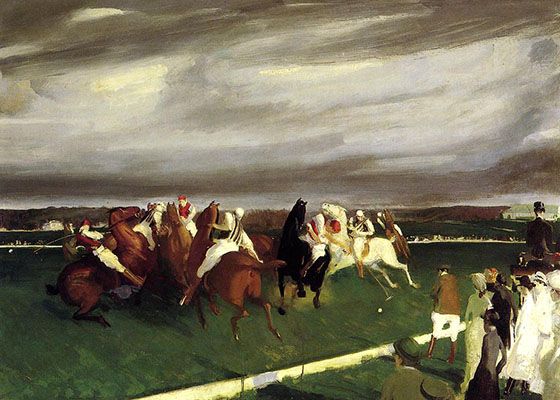
Polo at Lakewood
Set on a green field and under a stormy sky, the polo players are engaged in an equine sport played on the backs of black, brown, and white horses. A well-attired gathering of ladies and gentlemen watch the action at the left foreground of the canvas. While Bellows had often depicted sporting events, the polo match was a new theme for him; one that stood in sharp contrast to the working-class situations that dominated his earlier Ashcan School paintings. Bellows was introduced to the upper-class crowd and leisure activity by Joseph B. Thomas who, having purchased three of his paintings in 1908, invited Bellows to a tournament.
Polo at Lakewood is vast in scale, measuring almost four feet high and over six feet wide. When standing in front of the painting the spectator sees that it is formed of broad, barely-separated, brush strokes and daubs of paint. Bellows conveys the impression of spontaneity with the shape of the figures and with the juxtaposition of light and dark adding to the sense of dramatic action. The whole event must have been fascinating for Bellows who later commented wryly on his experience: "Let me say that these ultra rich have got some nerve tucked away under the breast pocket [...] It's an Aladdin's lamp sort of game [...] The players are nice looking; the horses are beautiful. I believe they brush their teeth and bathe them in goat's milk. It's a great subject to draw".
Oil on canvas - Collection of Columbus Museum of Art, Columbus, Ohio
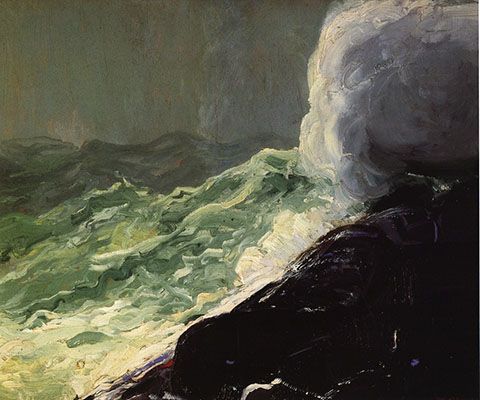
Churn and Break
In Churn and Break, rough waves, rendered in tones of blue, green, and yellow, crash into the black rocks occupying the right foreground. The white spume created by the waves hitting the rocks brings a fierce contrast to a landscape which is compounded by the dark storm clouds that fill the sky overhead. This is one of the many paintings Bellows produced during his stay on Monhegan Island in Maine during the summer of 1913. This was a highly productive period for the artist when he created no fewer than 117 works ranging from completed canvases to sketches (many of which he would turn into paintings when he returned to his studio in New York).
The time away from the gritty reality of the city proved to be a tonic for Bellows who thrived in the peace and quiet that the remote island offered. Moreover, he was not under the influences of others and able to create without outside interferences. As Bellows biographer Mary Sayre Haverstock noted, "his mentor, Henri, was not around to make suggestions, and his father was gone, too. So, in some ways, whether he realized it or not, Bellows was freer now to make decisions, artistic and economic, on his own". Bellows was captivated by the range of pictorial possibilities: "the island is endless in its wonderful variety", he wrote, "It's possessed of enough beauty to supply a continent". He was so enamoured by topography he returned to the area two summers later, producing his most primeval depictions of nature.
Oil on panel - Collection of Columbus Museum of Art, Columbus, Ohio
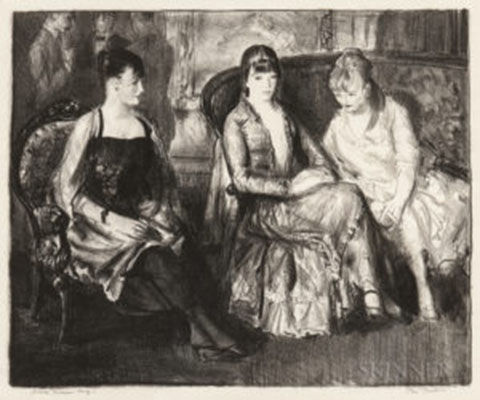
Elsie, Emma and Marjorie, Second Stone
Two practical factors influenced Bellows's decision to take up printmaking seriously. The first was a need to provide financially for his wife and two children - the quickly-produced lithographs offered him a steady stream of income. Second was more a matter of aesthetics. Bellows, whose studio was on an upper level on East 19th Street, quickly discovered that the winter months in the city robbed him of a dependable natural light source, making it more difficult to explore new possibilities with color and composition. Lithography offered a more immediate and more functional and creative outlet in this respect.
Bellows produced the majority of his lithographs, however, during the second half of his career, and while not a particularly revered medium amongst aficionados and purists, prints like Elsie, Emma and Marjorie, went a long way towards broadening the artist's popularity with the public. Like his paintings, his lithographs encompassed a wide range of subjects. Adding to his signature urban subject matter, for instance, Bellows's earliest lithographs (c.1916) were marked by a number of harrowing war scenes (Bellows had been deeply affected by the onset of WWI) and even a collection of nudes.
This family portrait belongs however to a later period when family life became a more predominant theme in his output. Though they lacked the gritty realism for which he was best known, his portraits embodied the sort of "observational" distance that marked all his work. Eugene and Elsie Speicher, and Robert and Marjorie Henri, were dear friends of George and Emma Bellows and this was one of several portraits of the group he produced. The three women are shown here in conversation on a settee and armchair, while their spouses are engrossed in conversation in the top left corner of the frame. Speicher, himself a successful portraitist, was part of the Woodstock art colony with which Bellows would soon become affiliated.
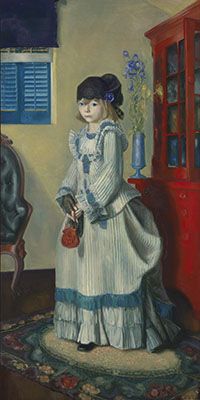
Lady Jean
In this late canvas a young girl is dressed in a blue pinstripe dress, black lace gloves, and dark blue hat clutching a small red bag. She stands in a domestic setting with a floral rug at her feet, a blue chair partially visible on the left, and a red hutch behind her next to which rests a blue flower vase.
In addition to his numerous realist scenes of city life, sports, and landscapes Bellows painted many portraits during his career. Here the subject is Bellows's nine-year old daughter Jean. Family was very important to Bellows which is reflected in this tender portrait. The picture of innocence, she looks out at the viewer with an intense stare. Sadly, this painting was created less than a year before Bellows's death, which would clearly alter her carefree childhood.
Working with models was an interesting endeavor for Bellows who once stated, "It's a queer thing about models. Do you know some people have the design of a painting in their features and their bodies, and some haven't". Perhaps that is why depictions of cherished family and friends was something he returned to often. To create this work, Bellows used a more controlled hand, giving up on the looser brushwork that characterized his street and landscape scenes. There is also a fuller complexity to the color choices of the work that make it compositionally advanced; here especially in the way that the red of the girl's bag echoes the red in the hutch behind her and the tall slender blue vase is reinforced in the tall column of blue in his daughter's dress. Bellows devoted his whole (but short) artistic life to the search for new ways to capture the essence of modern American life. It was in the pioneering spirit of this quest that his portraiture pushed existing boundaries for color and design.
Oil on canvas - Collection of Yale University Art Gallery, New Haven, Connecticut
Biography of George Bellows
Childhood and Education
George Bellows was born into a devout Methodist family consisting of his architect father, George Bellows Senior, and his mother Anna Wilhelmina Smith who came from Long Island, New York where her father worked as a whaling captain. His only sibling, a significantly older half-sister Laura, from his father's first marriage, moved away when George was only two years old.
Encouraged by his maternal aunt Elinor, Bellows's desire to become an artist took hold at an early age. He would often use discarded pieces of paper from his father's work desk to create his drawings which became popular with other children in his neighborhood. Upon request, he would make works for them that usually featured a marching line of animals or trains. In describing Bellows, one former neighbor Harriet Kirkpatrick stated, "Whenever I think of George, I think of a solemn little boy who sat on our stone front steps drawing on yards of ribbon paper. It was a command performance, and we would pay him with dates and figs".
The other love of Bellows's childhood was sports. Not being very tall or muscular as a child, Bellows still believed he had a better chance of proving himself as an athlete than an artist. Once, while serving as a scorekeeper, he was put in the game when one of the regular team players did not show up. He performed so well that he secured a permanent place on the team. But though Bellows continued to play sports in high school, his bigger interest was showing in his art classes, something his parents did not approve of or encourage.
Early Training
Despite a lack of familial support, Bellows enrolled in college at Ohio State University in 1901 with the intent of studying art. He soon began making drawings for school publications and created an oil painting that won an award at the state fair in 1903. His devotion to art was so strong in fact that he turned down an offer to play professional baseball with the Cincinnati Reds to focus on making a career as an artist.
As he progressed with his formal studies, Bellows realized that his training was restrictive and decided not to sit for his final examinations in 1904. Having intentionally failed his junior year, Bellows Senior accepted the fact that his son was serious about becoming an artist and supported him financially in his move to New York. It was after arriving in New York City in the summer of 1904 that Bellows's art studies began in earnest. He enrolled in the New York School of Art where he would mix with classmates including Edward Hopper, Rockwell Kent, and Edward Keefe. There he also met his future wife, and fellow art student, Emma Louise Story.
The greatest influence at this school however came from two tutors. Robert Henri helped to focus the direction of Bellows's art, and the two developed a friendship that would last for the rest of their lives; Bellows once stated that "Robert Henri is properly 'my father'". It was under Henri's direction that Bellows first took putting everyday life of New York City onto his canvases. In 1909, when Henri would break with the New York School of Art and open the Henri Art School, Bellows would follow him there. A second tutor, John Sloan, would also help to shape the direction of his early art and the two would go on outings together in search of everyday city subjects to paint.
Mature Period
Although never one of its number, the gritty subject matter of Bellows's paintings saw him linked to a group of progressive American artists who would become known as The Eight. The group, who earned their name of the back of a single 1908 touring exhibition, were brought together by Henri and promoted a unique brand of American realism that eventually expanded into what became known as The Ashcan School. Bellows did partake in a later exhibition organized by Henri, however. The Exhibition of Independent Artists opened in April 1910. It was held over three floors in a building at 29-31 West 35th Street and featured 260 paintings, 20 sculptures and 219 drawings and prints. The exhibition, for which Bellows also sat on the hanging committee, was not a commercial success but is now cited by historians as a landmark event in the early development of American modernism.
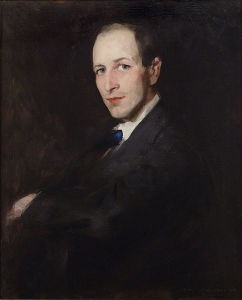
Bellows's success in early exhibitions led to the first of many teaching jobs. Throughout his career, Bellows would supplement his income with teaching posts and by making drawings for magazines such as American Magazine, Harper's, and The Masses. His first teaching appointment was perhaps the most important job on a personal level since, as an instructor in 1910 at the Arts Students League, he was able to obtain sufficient funds and financial security to marry Emma (which he did in September of that year). The wedding almost did not take place however since Bellows, deeply focused on his art, spent the morning working in his studio where he lost track of time, forgot the address of the church, and only just made the ceremony. Despite this, the marriage would be a happy one with Emma nurturing his career. She and their two daughters, Anne born in July 1911 and Jean born April 1915, would often serve as subjects for his portrait paintings.
Unlike many artists at the time, Bellows never felt the need to travel to Europe to paint; instead his inspiration came from the rich diversity that could be found in America. In addition to the lure of New York City, and time spent painting portraits, Bellows's subjects were often drawn from the many domestic locations he visited throughout his life; including California, the Catskills, Long Island, Maine, and Rhode Island.
Later Period
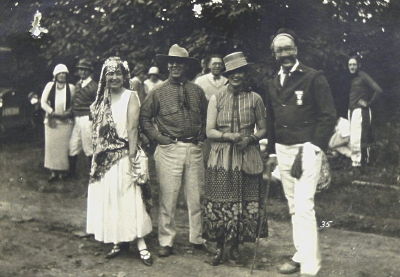
While paintings remained a key element of Bellows's output throughout his career, in the last decade of his life the artist developed an interest in lithography. He hired a press assistant, George C. Miller, to work with him in his studio and had a successful showing of his lithographs in 1916. As with his paintings, the subjects of his lithographs were diverse including a series of eighteen works on the horrors of World War I. He added to these several images of social outings and gatherings, and later, several family portraits.
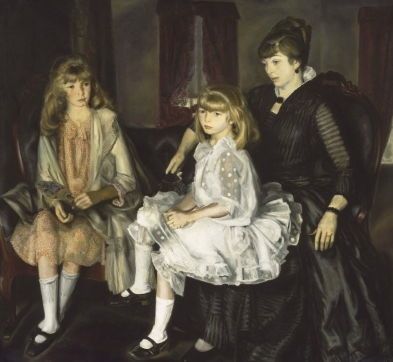
Often seeking refuge from the dense grind of the city, Bellows made what would be an important visit to Woodstock, New York in the summer of 1921. He and his family became so enamoured that they bought land there and in 1922 Bellows played a major role in building a home and studio. Woodstock provided a source of great inspiration for the artist resulting in many late career paintings and lithographs of which the artist once stated, "I am afraid I am getting into the Woodstock habit of working a month or so on a 'Masterpiece.' We will see what we shall see".
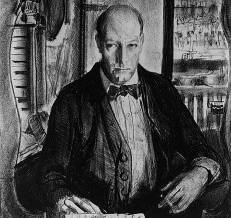
Unfortunately, Bellows would not have much time in Woodstock. In the summer of 1924, he developed stomach pains and learned he had issues with his appendix. Ignoring his pain, and the advice to seek urgent medical support, having celebrated the new year he was rushed to the hospital where he died of peritonitis a few days later, aged just forty-two.
The Legacy of George Bellows
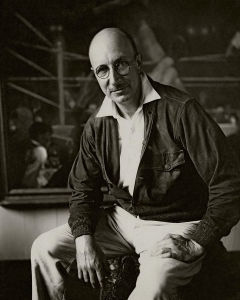
With his gritty depictions of everyday life in New York City George Bellows played a key role in the Ashcan School. His unapologetically raw paintings provided a record of the urban experience. In addition, through these works he demonstrated that modern art movements did not have to develop in Europe alone. Rather, he contributed to the advancement of a uniquely American approach to modern realist painting which laid the foundation for future generations of American artists to build upon.
In addition to his role as a painter, Bellows's legacy was further shaped by his dedication to and advancement of lithography. He defied the public attention on other forms of artmaking and succeeded in creating a market for lithographs of which biographer Mary Sayre Haverstock writes, "many of his friends advised him not to waste his time, because nobody collected lithographs anymore [...]. But Bellows was determined to put lithography on the map...". Paintings and lithographs by Bellows are held in all the major American galleries, while his 1919 painting Three Children was acquired by the White House in 2007 where it now proudly hangs in the Green Room.
Influences and Connections

-
![Robert Henri]() Robert Henri
Robert Henri -
![Edward Hopper]() Edward Hopper
Edward Hopper -
![Rockwell Kent]() Rockwell Kent
Rockwell Kent - Edward Keefe
- Kenneth Hayes Miller
- George C. Miller
- Joseph Russell Taylor
- Joseph B. Thomas
-
![Robert Henri]() Robert Henri
Robert Henri -
![Edward Hopper]() Edward Hopper
Edward Hopper -
![Rockwell Kent]() Rockwell Kent
Rockwell Kent - Edward Keefe
- Kenneth Hayes Miller
- George C. Miller
- Joseph Russell Taylor
- Joseph B. Thomas
Useful Resources on George Bellows
- George Bellows: American Artistby Joyce Carol Oates
- George Bellows: An Artist in ActionOur Pickby Mary Sayre Haverstock
 Ask The Art Story AI
Ask The Art Story AI